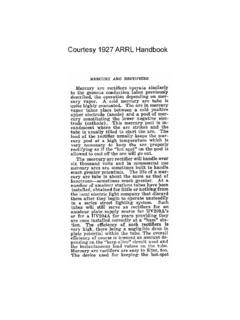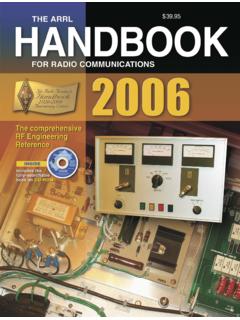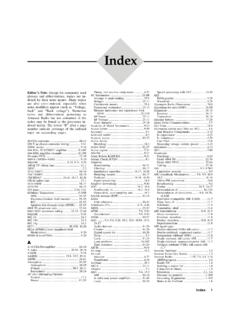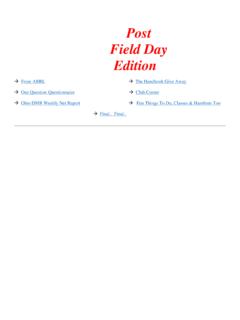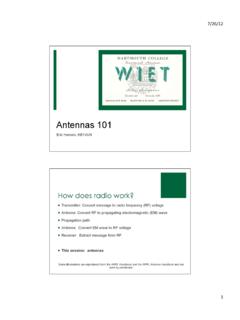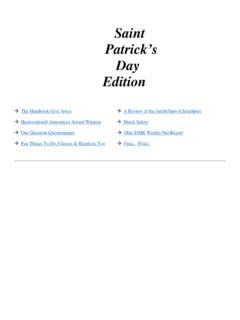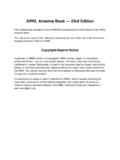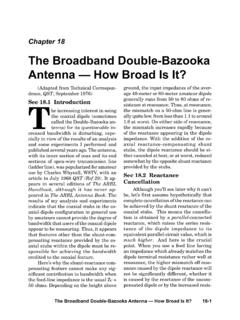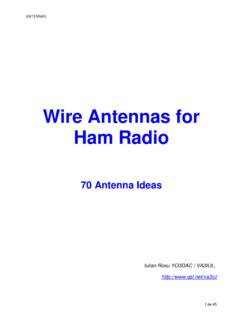Transcription of HBR-11 and 1962 ARRL HF Crystal Filter SSB Transceiver …
1 1 HBR-11 and 1962 arrl HF Crystal Filter SSB Transceiver station A Vintage Homebrew Transmitter/Receiver by KC9 KEP The 1960 s were the years that Ham Radio made an impression on me. I ve always found vacuum tube technology intriguing. Like the old coal burning locomotives, they re high maintenance, inefficient and run hot, but they have character that cannot be denied. So, when I returned to ham radio, I knew I had to build my own equipment, and it had to be done with tubes! The Receiver - I had constructed several tube receivers starting in the year 2000, but my best performing receiver was the Ted Crosby HBR or Home Brewed Receiver.
2 Ted s receiver designs first appeared in QST magazine in 19571 and again as recently as 20092. A quick search on the arrl s QST archive indicates at least a dozen different references to this design, so it was quite popular in its day! 1 QST July 1957 ( Pg. 11-17, 148, 150) - Ham-Band 14 tube Double-Conversion Receiver Ted Crosby W6TC 2 QST Feb 2009 - (Pg. 96) Ted Crosby W6TC, and the HBR Receiver - Dilks III, John H., K2 TQN The SSB Transmitter - I had considered several different technologies before selecting the design that I decided to replicate.
3 I shied away from the SSB phasing methodology as well as the DSSC (Double Sideband Suppressed Carrier) designs and decided to go with a Filter rig. I located the earliest Filter -SSB transmitter featured in the arrl handbooks. The transmitter design of choice first appeared in the 1962 arrl Handbook3. My goal was to replicate the handbook transmitter in appearance as well as in functionality. Construction - For both units, I created my chassis on a sheer and brake and utilized aluminum. Black anodized aluminum was used for the front panels. The graphics on the panels were created in CorelDRAW and laser engraved, which produces a nice factory finished appearance.
4 Procuring parts was one of the biggest hurdles. Luckily, vacuum tubes are still routinely sold 3 arrl handbook - 39th edition A High-Frequency Crystal - Filter Sideband Exciter . 2 through online vendors and Amateur Radio swap-fests. Frequently, I will purchase a component that is not immediately needed if it appears to be something that could be used for future products. One eventually stockpiles quite an arsenal of radio parts! In some cases, I have utilized my own homebrewed coil-winder4 in order to create coils that are no longer available.
5 It was actually easier for me to get the receiver operating than it was to get the SSB transmitter debugged. In the case of the receiver, I was able to simultaneous test and validate the circuitry as I fabricated sections. I started with the audio amplifier and worked backwards towards the front end of the receiver. The transmitter required a great deal of tribal knowledge to get working to an appreciable level. I learned that it is important to use non-inductive disc capacitors with very short leads to bypass all power supply and even filament connections. I also discovered that even short lengths of shielded cable, when used to prevent internal signal leakage, provided more than enough capacitance to de-tune critical circuits.
6 Small metal shielding sub enclosures prevented leakage between critical circuits. Measuring the performance of tank coils and filters required specialized tools. Some devices, such as a grid dip meter are extremely helpful. A spectrum analyzer is another great tool for verifying Filter operation. I quickly learned that I had to fabricate near field probes in order to measure circuit performance without loading down the circuit under test! Operation - But, even when the transmitter and receiver are operational, one is not on the air 4 YouTube-Video Morris Gingery Ham Radio Coil Winder KC9 KEP yet!
7 The operator needs a way to get the equipment operating in unison for the sake of ease of operation. If you think about what happens when you key a Transceiver ; 1.) The antenna must be disconnected from the receiver. 2.) He antenna connection to the receiver must be shorted to ground. 3.) The receiver must be muted in some fashion. 4.) The antenna must be connected to the transmitter. 5.) The transmitter must be keyed. This process must be followed in reverse when you want to receive again. And, that is just what I was doing manually, during my initial QSO s! Also, the tube equipment will drift off frequency for some time due to heating, until it stabilizes.
8 This requires the operator to perform periodic minor tweaks in the tuning of the receiver while QSO-ing. All this can keep the operator busier than a one legged man in a butt kicking contest! The station needs a T/R Sequencer to manage these tasks for you. I found such a device named The At Last T/R Sequencer 5. It s a really nifty device that is PIC controller operated and is programmable via a serial link to a laptop. I did add a relay to switch over the antenna, but all is controlled by the T/R sequencer and one foot switch. Very handy indeed! Additionally, one needs a way to select multiple stable frequencies on which to transmit.
9 I started with FT-243 crystals. But, here s the trouble that crystals created; 5 Mar 2007 - QST (Pg. 32) - The "At Last!" Radio TR Sequencer - Zauhar, Bertrand, VE2 ZAZ 3 Imagine that you d like to transmit at 3760 KHz for a QSO. Just plug in a 3760 KHz Crystal , right? Nope! Here s what happens: The transmitter s suppressed carrier frequency Crystal for lower side band is MHz. This frequency has to be heterodyned (or mixed ) with another stable oscillator to become converted to 3760 KHz. Simple subtraction indicates that a KHz Crystal is required.
10 Prior to the advent of digital tuning, it didn t matter too much exactly what frequency you QSO-d at, as long as you were at the same frequency as your recipient .. and that you weren t operating on an illegal frequency! My solution to remedy this quagmire? The NorCal FCC-1 & FCC-2 Direct Digital Synthesis VFO kit6. I suppose to a tube-purist, this may be cheating , but it resolves the issue of tube VFO drift as well. I feel it justifies stepping out of the hollow state realm this one time. Among the plethora of abilities of the FCC-1/FCC-2 is the ability to be programmed for any offsets desired.
